Factsheets
About the High-Speed Rail Program
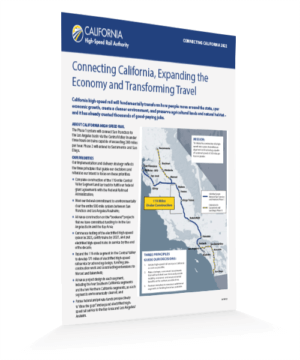 This is a quick snapshot of the overall program and how it will transform mobility, spur economic growth, create a cleaner environment, and preserve agricultural lands and natural habitats.
This is a quick snapshot of the overall program and how it will transform mobility, spur economic growth, create a cleaner environment, and preserve agricultural lands and natural habitats.
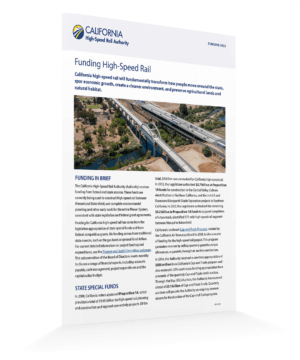 The California High-Speed Rail Authority receives funding from federal and state sources which is being used to fund construction, environmental planning and other early work.
The California High-Speed Rail Authority receives funding from federal and state sources which is being used to fund construction, environmental planning and other early work.
Keeping High-Speed Rail Moving
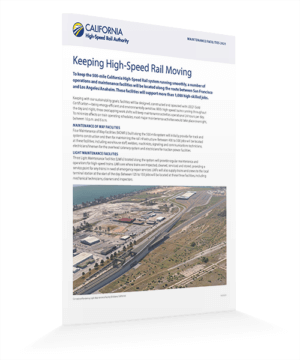 High-speed rail operations will require five different facility types: Maintenance of Way (MOW) facilities, Light Maintenance Facilities (LMF), a Heavy Maintenance Facility (HMF), an Operations Control Center, and operations management headquarters.
High-speed rail operations will require five different facility types: Maintenance of Way (MOW) facilities, Light Maintenance Facilities (LMF), a Heavy Maintenance Facility (HMF), an Operations Control Center, and operations management headquarters.
High-Speed, High-Capacity Transportation
 Despite planned investments in airports and highways, California is facing a transportation capacity crisis. To keep pace, California must expand its transportation capacity to improve mobility.
Despite planned investments in airports and highways, California is facing a transportation capacity crisis. To keep pace, California must expand its transportation capacity to improve mobility.
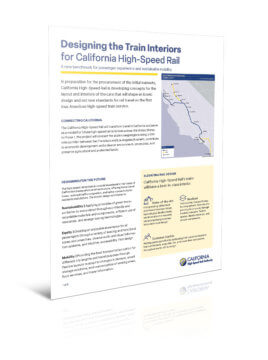 In preparation for the procurement of the initial trainsets, California High-Speed Rail is developing concepts for the layout and interiors of the cars that will shape an iconic design and set new standards for rail travel on the first true American high-speed train service.
In preparation for the procurement of the initial trainsets, California High-Speed Rail is developing concepts for the layout and interiors of the cars that will shape an iconic design and set new standards for rail travel on the first true American high-speed train service.
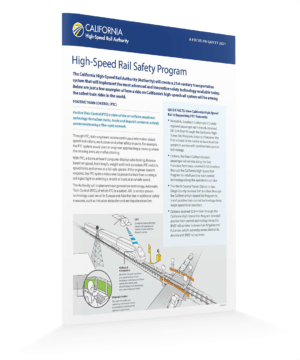 The California High-Speed Rail Authority is committed to safety on trains and surrounding train lines. Learn more about the measures being taken to protect you.
The California High-Speed Rail Authority is committed to safety on trains and surrounding train lines. Learn more about the measures being taken to protect you.
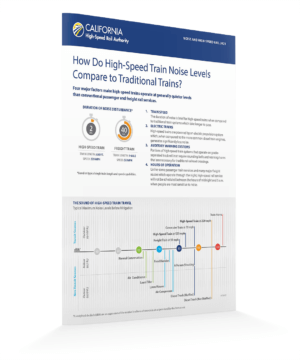 Four major factors make high-speed trains operate at generally quieter levels than conventional passenger and freight rail services.
Four major factors make high-speed trains operate at generally quieter levels than conventional passenger and freight rail services.
Our Commitment to Diversity, Equity and Inclusion
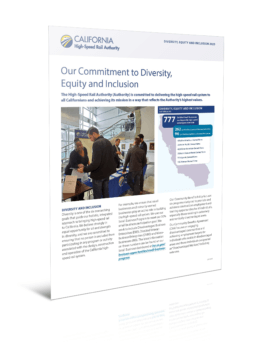 We’re committed to delivering the high-speed rail system to all Californians and achieving its mission in a way that reflects the Authority’s highest values.
We’re committed to delivering the high-speed rail system to all Californians and achieving its mission in a way that reflects the Authority’s highest values.
High-Speed Rail: An International Success Story
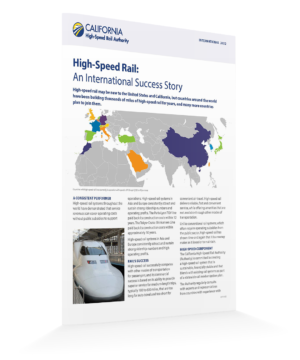 High-speed rail may be new to the United States and California, but countries around the world have been building thousands of miles of high-speed rail for years, and many more countries plan to join them.
High-speed rail may be new to the United States and California, but countries around the world have been building thousands of miles of high-speed rail for years, and many more countries plan to join them.
High-Speed Rail in Northern California
Northern California at a Glance
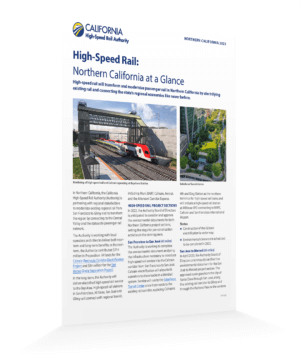 High-speed rail will provide clean, modern transportation for the millions of Northern California residents and will help tie the state’s economies together like never before.
High-speed rail will provide clean, modern transportation for the millions of Northern California residents and will help tie the state’s economies together like never before.
High-Speed Rail in the Central Valley
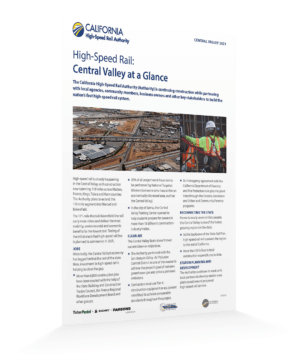 High-speed rail is already happening in the Central Valley, with construction now spanning 119 miles across Madera, Fresno, Kings, Tulare and Kern counties.
High-speed rail is already happening in the Central Valley, with construction now spanning 119 miles across Madera, Fresno, Kings, Tulare and Kern counties.
Merced to Bakersfield Line: Connecting the Central Valley to California
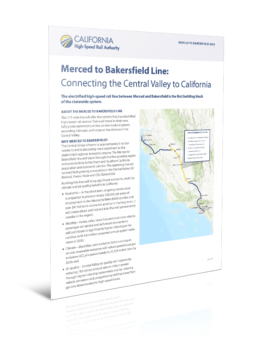 The electrified high-speed rail line between Merced and Bakersfield is the first building block of the statewide system. This 171-mile line will offer the nation’s first true electrified high-speed rail service.
The electrified high-speed rail line between Merced and Bakersfield is the first building block of the statewide system. This 171-mile line will offer the nation’s first true electrified high-speed rail service.
High-Speed Rail in Southern California
Southern California at a Glance
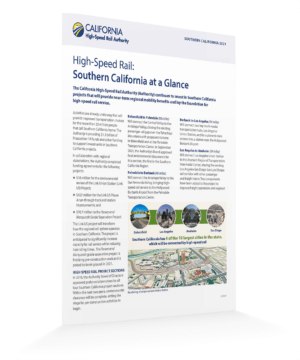 The Authority continues its work in partnership with agencies, corridor cities, interested stakeholders and the public to bring the nation’s first high-speed rail to Southern California.
The Authority continues its work in partnership with agencies, corridor cities, interested stakeholders and the public to bring the nation’s first high-speed rail to Southern California.
Caltrans Y El Tren De Alta Velocidad: Construyendo Al Futuro
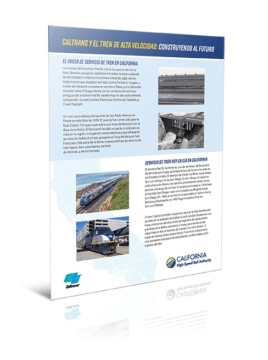 En asociación con Caltrans y la Fundación de Los Angeles Railroad Heritage, instalamos una nueva exhibición que cuenta la historia del pasado, presente y futuro de los viajes en tren en California. La instalación está ubicada en Philippe The Original, el emblemático restaurante de Los Ángeles fundado en 1908.
En asociación con Caltrans y la Fundación de Los Angeles Railroad Heritage, instalamos una nueva exhibición que cuenta la historia del pasado, presente y futuro de los viajes en tren en California. La instalación está ubicada en Philippe The Original, el emblemático restaurante de Los Ángeles fundado en 1908.
Federal Grant Awards & Applications
For information on grants awarded to the Authority and pending federal grant applications, visit our Federal Grants webpage.
Benefits of High-Speed Rail
The Economic Impact of California High-Speed Rail
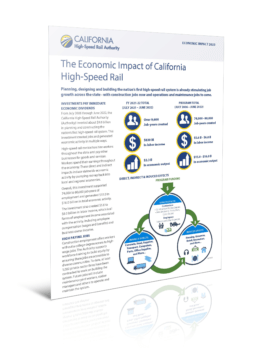 A look at how investment in the nation’s first high-speed rail system has created jobs and generated economic activity in numerous ways.
A look at how investment in the nation’s first high-speed rail system has created jobs and generated economic activity in numerous ways.
High-Speed Rail: Creating Jobs
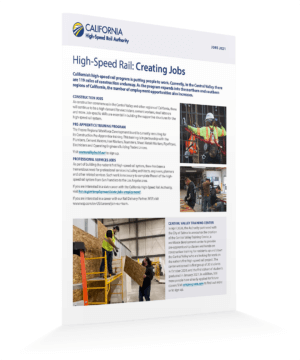 California’s high-speed rail program is putting people to work. The number of employment opportunities continues to increase as the program expands.
California’s high-speed rail program is putting people to work. The number of employment opportunities continues to increase as the program expands.
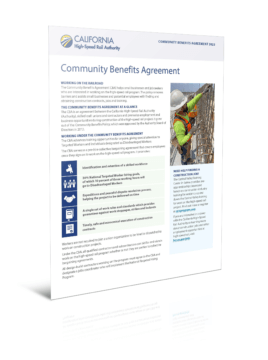 The Community Benefits Agreement (CBA) helps small businesses and job seekers who are interested in working on the high-speed rail program. The policy removes barriers and assists small businesses and potential employees with finding and obtaining construction contracts, jobs and training.
The Community Benefits Agreement (CBA) helps small businesses and job seekers who are interested in working on the high-speed rail program. The policy removes barriers and assists small businesses and potential employees with finding and obtaining construction contracts, jobs and training.
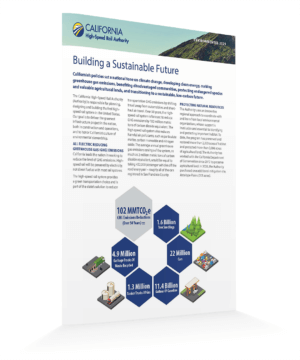 California’s policies set a national tone on environmental issues. The goal is to deliver the greenest infrastructure project in the nation, both in construction and operations, and to honor California’s culture of environmental stewardship.
California’s policies set a national tone on environmental issues. The goal is to deliver the greenest infrastructure project in the nation, both in construction and operations, and to honor California’s culture of environmental stewardship.
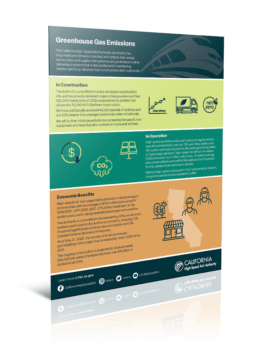 The Authority has long-held commitments matched with actions that reduce construction and supply chain greenhouse gas emissions while delivering a system that is the backbone for transferring medium and long-distance trips to completely zero-carbon rail.
The Authority has long-held commitments matched with actions that reduce construction and supply chain greenhouse gas emissions while delivering a system that is the backbone for transferring medium and long-distance trips to completely zero-carbon rail.
Student Leadership in High-Speed Rail Transportation
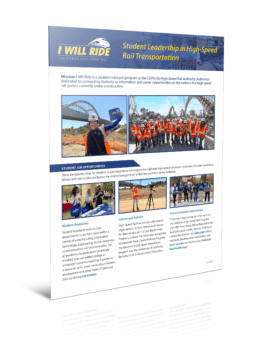 I Will Ride is a student outreach program at the California High-Speed Rail Authority (Authority) dedicated to connecting students to information and career opportunities on the nation’s first high-speed rail system currently under construction.
I Will Ride is a student outreach program at the California High-Speed Rail Authority (Authority) dedicated to connecting students to information and career opportunities on the nation’s first high-speed rail system currently under construction.
Small Business Program
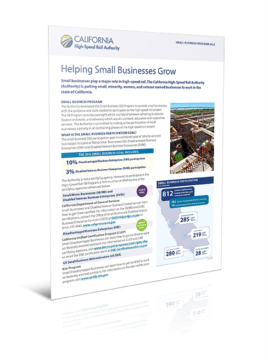 More about the Authority’s Small Business Program and how to get involved.
More about the Authority’s Small Business Program and how to get involved.
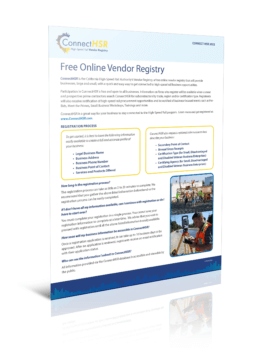 How to get registered and stay connected.
How to get registered and stay connected.
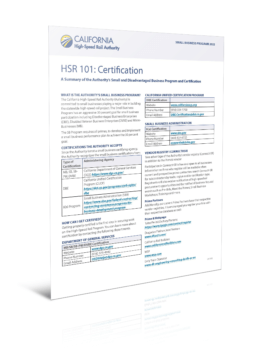 A summary of the Authority’s Small and Disadvantaged Business Program and the certification process.
A summary of the Authority’s Small and Disadvantaged Business Program and the certification process.
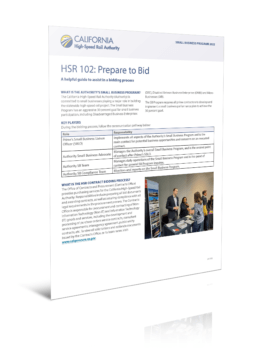 A helpful guide to assist in a bidding process.
A helpful guide to assist in a bidding process.
 A summary of what to do before you sign the contract/agreement.
A summary of what to do before you sign the contract/agreement.
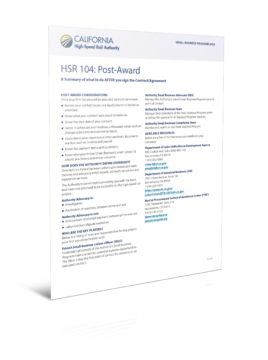 A summary of what to do after you sign the contract/agreement.
A summary of what to do after you sign the contract/agreement.
Get the Facts
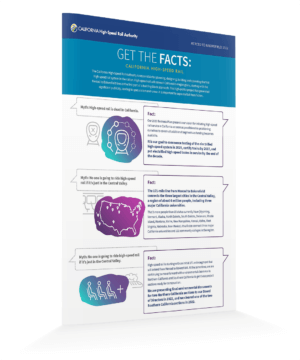 High-speed rail will connect California’s mega-regions, starting with the Merced to Bakersfield line as the first part of a building block approach.
High-speed rail will connect California’s mega-regions, starting with the Merced to Bakersfield line as the first part of a building block approach.
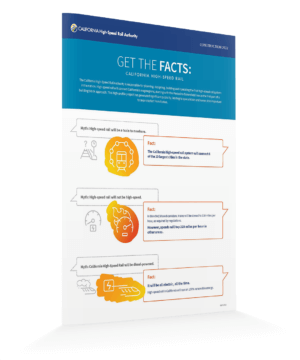 The high-speed rail project has garnered a lot of publicity leading to speculation and rumor, making it important to separate fact from fiction.
The high-speed rail project has garnered a lot of publicity leading to speculation and rumor, making it important to separate fact from fiction.
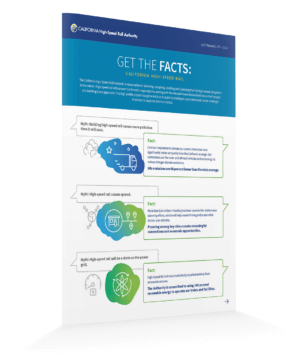 The Authority is committed to building a high-speed rail system that minimizes impacts to both the natural and built environment, encourages compact land development around transit stations and helps California manage its pressing issues with climate change, traffic and airport congestion, and energy dependency.
The Authority is committed to building a high-speed rail system that minimizes impacts to both the natural and built environment, encourages compact land development around transit stations and helps California manage its pressing issues with climate change, traffic and airport congestion, and energy dependency.
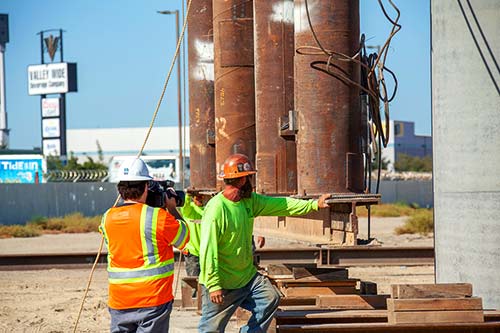
The California High-Speed Rail Authority makes every effort to ensure the website and its contents meet mandated ADA requirements as per the California State mandated Web Content Accessibility Guidelines 2.0 Level AA standard. If you are looking for a particular document not located on the California High-Speed Rail Authority website, you may make a request for the document under the Public Records Act through the Public Records Act page. If you have any questions about the website or its contents, please contact the Authority at info@hsr.ca.gov.

